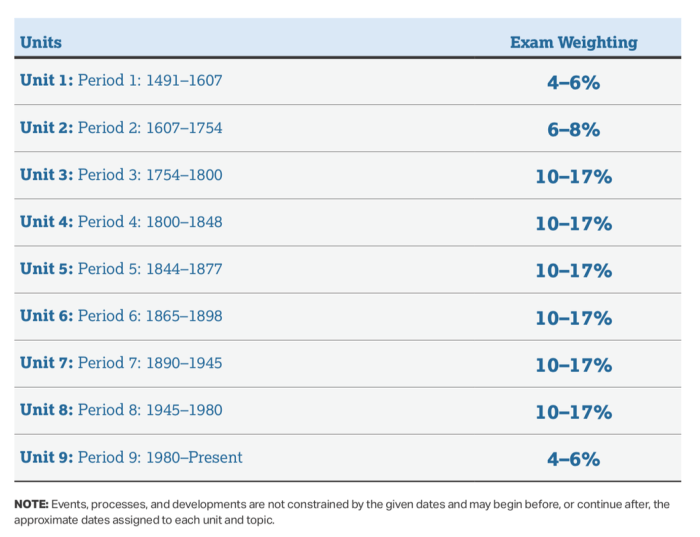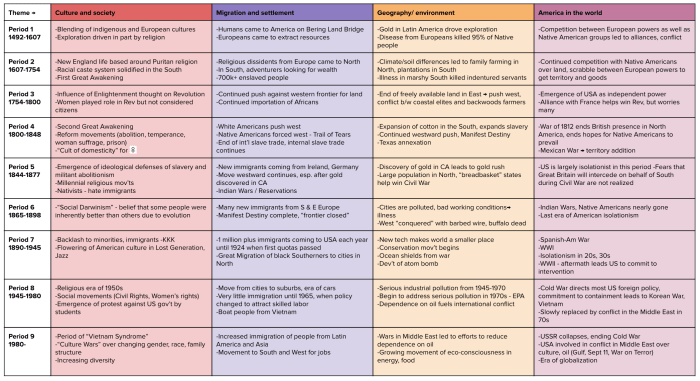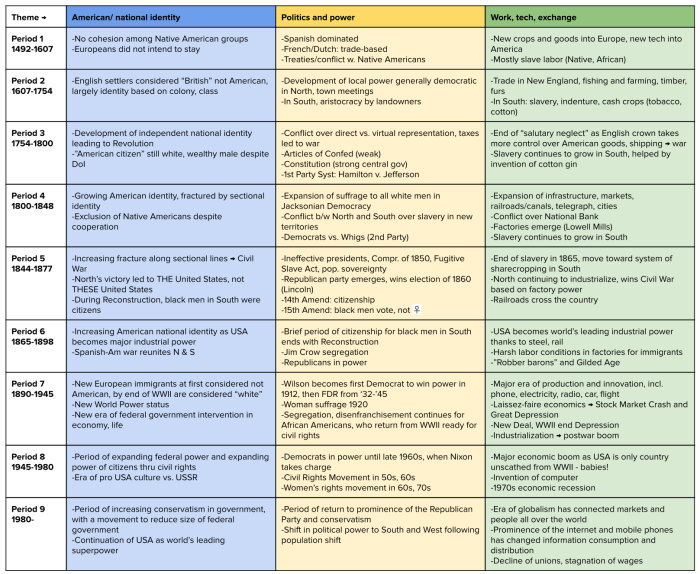Apush unit 6 mcq practice – Embark on an engaging journey through APUSH Unit 6 with our meticulously crafted MCQ practice guide. Dive into a comprehensive exploration of key historical concepts, figures, and themes, preparing you for success on the APUSH exam.
This guide provides a deep dive into the historical context, key figures, and events that shaped this era, equipping you with a thorough understanding of the material. Explore historical themes and concepts, connecting them to broader contexts, and discover effective test-taking strategies to maximize your performance.
MCQ Practice Questions

To excel in the APUSH Unit 6 exam, it’s crucial to master the key concepts and historical events covered in the unit. This comprehensive list of multiple-choice questions will challenge your understanding and prepare you for the exam format.
These questions cover a wide range of topics, from the American Revolution to the Civil War and Reconstruction. By practicing with these questions, you’ll reinforce your knowledge, identify areas for improvement, and build confidence in your exam readiness.
The American Revolution
- The primary catalyst for the American Revolution was the British Parliament’s imposition of taxes without representation on the American colonies.
- The Declaration of Independence, drafted by Thomas Jefferson, Artikeld the colonists’ grievances against British rule and proclaimed their right to self-governance.
- The Battle of Saratoga was a turning point in the American Revolution, as it convinced France to recognize American independence and provide military support.
The Confederation and Constitution
- The Articles of Confederation, ratified in 1781, established a loose confederation of states with limited federal power.
- The Constitutional Convention, held in Philadelphia in 1787, drafted a new Constitution that established a stronger federal government with three branches: executive, legislative, and judicial.
li>The Bill of Rights, ratified in 1791, added ten amendments to the Constitution, guaranteeing individual liberties and limiting the power of the federal government.
Expansion and Reform
- The Louisiana Purchase in 1803 doubled the size of the United States and opened up new territories for westward expansion.
- The Indian Removal Act of 1830 authorized the forced relocation of Native American tribes from their ancestral lands east of the Mississippi River.
- The Second Great Awakening, a religious revival movement, swept across the United States in the early 19th century, leading to the rise of new religious denominations and social reform movements.
The Civil War, Apush unit 6 mcq practice
- The election of Abraham Lincoln in 1860, who opposed the expansion of slavery into new territories, led to the secession of several Southern states and the outbreak of the Civil War.
- The Battle of Gettysburg, fought in 1863, was a major turning point in the Civil War, marking the beginning of the Union’s victory.
- The Emancipation Proclamation, issued by President Lincoln in 1863, freed slaves in Confederate-held territory and marked a significant step towards the abolition of slavery.
Reconstruction
- The Reconstruction Era, following the Civil War, aimed to reunite the country, protect the rights of freed slaves, and rebuild the war-torn South.
- The Radical Republicans, a faction within the Republican Party, advocated for a harsh Reconstruction policy that would punish the former Confederate states and ensure the rights of African Americans.
- The Compromise of 1877 ended Reconstruction and resulted in the withdrawal of federal troops from the South, effectively ending the federal government’s efforts to protect the rights of African Americans.
Historical Context and Background

APUSH Unit 6 delves into a pivotal period in American history, encompassing the years 1877 to 1914. This era witnessed transformative events that shaped the nation’s economic, social, and political landscape.
The post-Reconstruction era saw the rise of industrialization, urbanization, and the emergence of a new social order. Technological advancements fueled economic growth, while the influx of immigrants from Europe and Asia transformed the nation’s demographics and culture.
Major Events and Developments
- Reconstruction (1865-1877): Efforts to rebuild the South after the Civil War
- Compromise of 1877: Ended Reconstruction and withdrew federal troops from the South
- Industrial Revolution: Rapid technological advancements and factory production
- Urbanization: Growth of cities due to industrialization and immigration
- New Immigration: Waves of immigrants from Europe and Asia
- Populism: A political movement advocating for farmers and laborers
- Spanish-American War (1898): Conflict with Spain over Cuba
- Progressive Era (1890s-1920s): Reform movement addressing social and economic issues
Timeline of Key Events
| Year | Event |
|---|---|
| 1865 | End of the Civil War |
| 1865-1877 | Reconstruction |
| 1877 | Compromise of 1877 |
| 1890s-1920s | Progressive Era |
| 1898 | Spanish-American War |
Key Figures and Events: Apush Unit 6 Mcq Practice

Unit 6 of APUSH explores the tumultuous era of the American Revolution and the formation of the United States. This period witnessed the rise of iconic figures who played pivotal roles in shaping the nation’s destiny. Furthermore, several key events served as catalysts for revolutionary change and left an enduring mark on American history.
George Washington
- Role:Commander-in-Chief of the Continental Army, first President of the United States
- Motivations:Patriotism, belief in republican ideals
- Contributions:Led the American forces to victory in the Revolutionary War, established the precedent of a two-term presidency
Thomas Jefferson
- Role:Author of the Declaration of Independence, third President of the United States
- Motivations:Enlightenment ideals, belief in individual liberty
- Contributions:Drafted the Declaration of Independence, expanded the nation’s territory through the Louisiana Purchase
Benjamin Franklin
- Role:Diplomat, inventor, scientist
- Motivations:Enlightenment values, desire for scientific advancement
- Contributions:Negotiated the Treaty of Paris (1783), invented the lightning rod
Key Events
In addition to the contributions of these key figures, several pivotal events shaped the course of the American Revolution:
Battles of Lexington and Concord
- Date:April 19, 1775
- Significance:Marked the beginning of armed conflict between British troops and American colonists
Declaration of Independence
- Date:July 4, 1776
- Significance:Proclaimed the American colonies’ independence from Great Britain
Battle of Yorktown
- Date:October 19, 1781
- Significance:Decisive American victory that led to the surrender of the British army
Treaty of Paris
- Date:September 3, 1783
- Significance:Officially ended the Revolutionary War and recognized the independence of the United States
Historical Themes and Concepts

The study of APUSH Unit 6 delves into a multitude of historical themes and concepts that have shaped the course of American history. These themes provide a framework for understanding the events, movements, and ideas that have influenced the development of the United States.One
prominent theme is the concept of sectionalism, which refers to the division of the country along regional lines. This division was particularly evident during the antebellum period, as the North and South developed distinct economic, social, and political systems. The issue of slavery became a central point of contention between these two regions, ultimately leading to the outbreak of the Civil War.Another
important theme is the rise of industrialization and urbanization. The Industrial Revolution transformed the American economy and society, leading to the growth of cities and the emergence of a new working class. This period also witnessed the development of new technologies and innovations, such as the telegraph, the railroad, and the steamboat, which had a profound impact on transportation, communication, and commerce.The
expansion of the United States westward is another significant theme covered in this unit. The westward movement was driven by a desire for land, resources, and economic opportunity. As settlers moved west, they encountered and often clashed with Native American tribes, leading to conflicts and displacement.
The expansion of the United States also had a profound impact on the environment, as vast tracts of land were cleared for agriculture and development.The struggle for equality and civil rights is another central theme in APUSH Unit 6. The abolitionist movement fought to end slavery, while the women’s suffrage movement fought for women’s right to vote.
These movements faced significant resistance, but they ultimately achieved their goals and helped to shape the course of American history.These historical themes and concepts are interconnected and have had a lasting impact on the United States. By understanding these themes, students can gain a deeper appreciation for the complexity and richness of American history.
Sectionalism
Sectionalism was a major force in American history, particularly during the antebellum period. The North and South developed distinct economic, social, and political systems, which led to tensions and conflicts between the two regions.The North was primarily industrial and urban, with a diverse population of immigrants and free laborers.
The South, on the other hand, was largely agricultural and rural, with a plantation economy based on slave labor. These economic differences led to political divisions, as the North favored policies that supported industry and commerce, while the South favored policies that protected slavery and agriculture.The
issue of slavery became the central point of contention between the North and South. Abolitionists in the North demanded the end of slavery, while slaveholders in the South defended the institution as necessary for their way of life. The debate over slavery intensified in the 1850s, leading to the outbreak of the Civil War in 1861.The
APUSH Unit 6 MCQ practice can be challenging, but it’s important to know the content inside and out. For instance, knowing the different words with t h r e e i can help you answer questions about the Industrial Revolution.
So, brush up on your vocabulary and ace that APUSH Unit 6 MCQ!
Civil War was a bloody and costly conflict that resulted in the abolition of slavery and the preservation of the Union. However, the legacy of sectionalism continued to shape American history, as the North and South remained divided on many issues, including civil rights, economic development, and foreign policy.
Industrialization and Urbanization
The Industrial Revolution transformed the American economy and society in the late 19th century. New technologies and innovations, such as the telegraph, the railroad, and the steamboat, revolutionized transportation, communication, and commerce. These advances led to the growth of cities and the emergence of a new working class.The
Industrial Revolution had a profound impact on the American workforce. Many workers left farms and rural areas to find jobs in factories and cities. The working conditions in these factories were often harsh and dangerous, and workers faced long hours, low wages, and few benefits.
The rise of labor unions and the Progressive Era movement helped to improve working conditions and protect the rights of workers.The growth of cities also had a significant impact on American society. Cities became centers of commerce, culture, and entertainment.
However, they also faced challenges such as overcrowding, poverty, and crime. The Progressive Era movement addressed these issues with reforms such as public health measures, housing codes, and child labor laws.
Expansion and Conflict
The westward expansion of the United States was a major theme in the 19th century. Settlers moved west in search of land, resources, and economic opportunity. As they moved west, they encountered and often clashed with Native American tribes, leading to conflicts and displacement.The
expansion of the United States also had a profound impact on the environment. Vast tracts of land were cleared for agriculture and development, which led to deforestation, soil erosion, and the loss of wildlife habitat. The government’s policies toward Native Americans and the environment were often shortsighted and harmful.The
westward expansion culminated in the Mexican-American War of 1846-1848. The United States emerged from the war victorious and acquired a vast new territory, including present-day California, Nevada, Utah, and parts of Arizona, New Mexico, and Colorado. The war also increased tensions between the North and South, as the issue of slavery in the new territories became a major point of contention.
Equality and Civil Rights
The struggle for equality and civil rights has been a central theme in American history. The abolitionist movement fought to end slavery, while the women’s suffrage movement fought for women’s right to vote. These movements faced significant resistance, but they ultimately achieved their goals and helped to shape the course of American history.The
abolitionist movement began in the early 19th century and gained momentum in the decades leading up to the Civil War. Abolitionists argued that slavery was a moral evil and that it violated the principles of freedom and equality. They used a variety of tactics to promote their cause, including public speaking, writing, and political activism.The
women’s suffrage movement also began in the early 19th century. Suffragists argued that women had the same right to vote as men. They faced significant opposition from both men and women, but they persevered and eventually achieved their goal of women’s suffrage in 1920.The
struggle for equality and civil rights continues to this day. The Civil Rights Movement of the 1950s and 1960s fought to end segregation and discrimination against African Americans. The movement achieved major victories, including the passage of the Civil Rights Act of 1964 and the Voting Rights Act of 1965. However, the struggle for equality is ongoing, as issues such as racial profiling, police brutality, and mass incarceration continue to plague American society.
Test-Taking Strategies

Multiple-choice questions (MCQs) are a common assessment format in APUSH. To excel in these exams, effective test-taking strategies are crucial. Here are some tips to help you approach MCQs with confidence:
Question Types
MCQs can vary in format. Some common types include:
-
-*Factual questions
These questions test your knowledge of specific historical facts, dates, or events.
-*Analytical questions
These questions require you to apply your historical understanding to analyze a situation or make inferences.
-*Interpretation questions
These questions present a primary or secondary source and ask you to interpret its meaning or significance.
Time Management
Time management is essential during MCQ exams. Allocate your time wisely, spending more time on challenging questions and less on easier ones. Use the following tips:
-
-*Read the instructions carefully
Make sure you understand the number of questions, the time limit, and any specific instructions.
-*Preview the questions
Before starting, quickly scan the questions to get an overview of the topics covered.
-*Pace yourself
Divide the time evenly among the questions, leaving some time for review at the end.
Question Selection
Start with the questions you feel most confident about. This will boost your confidence and help you manage your time effectively. If you encounter a challenging question, move on to the next one and come back to it later if time permits.
Answer Elimination
When answering MCQs, try to eliminate incorrect choices before selecting an answer. Read the question and answer choices carefully, considering the context and your historical knowledge. By eliminating obviously wrong answers, you increase your chances of choosing the correct one.
Question & Answer Hub
What key concepts are covered in this MCQ practice guide?
This guide covers key historical concepts, events, and figures from APUSH Unit 6, including the American Revolution, the Constitution, and westward expansion.
How can I effectively prepare for the APUSH exam using this guide?
By practicing with the multiple-choice questions in this guide, you can familiarize yourself with the exam format, test your understanding, and identify areas for improvement.
What makes this MCQ practice guide unique?
This guide combines comprehensive content with effective test-taking strategies, providing a holistic approach to exam preparation.
